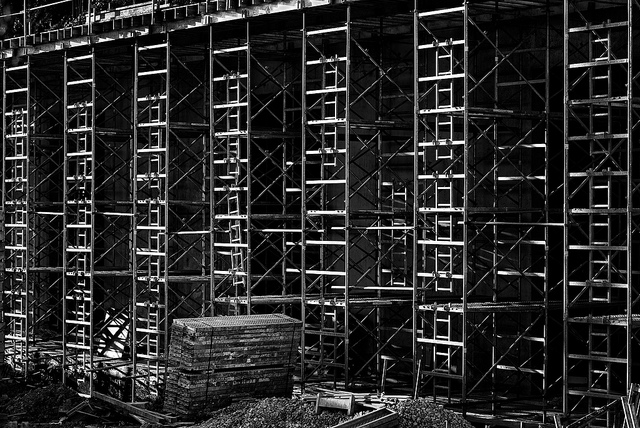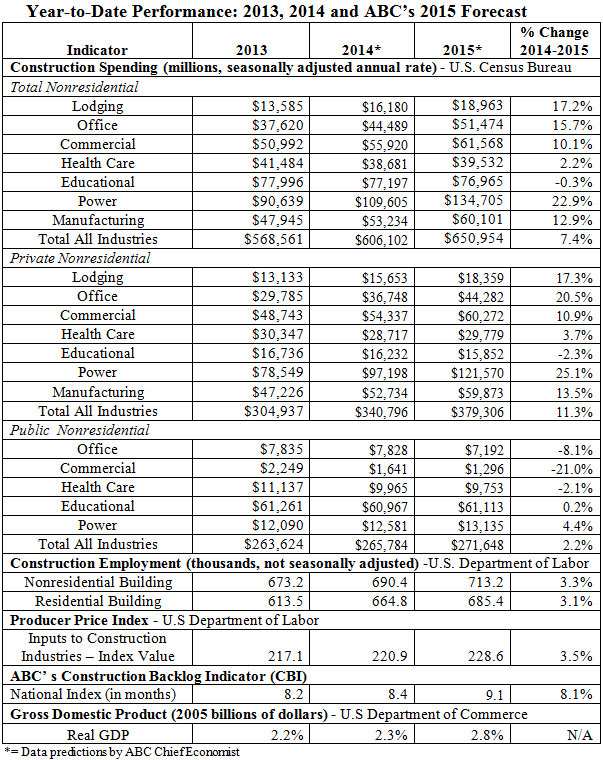Associated Builders and Contractors (ABC) forecasts a steady and ongoing economic recovery for the U.S. commercial and industrial construction industries in 2015. The reasonably brisk industry recovery in 2014 should continue in 2015, with momentum especially growing in segments closely related to the current American energy and industrial production resurgence.
"ABC forecasts nonresidential construction spending will expand by roughly 7.5% next year," said ABC Chief Economist Anirban Basu. "The segments that will experience the largest growth in construction spending in 2015 include power (e.g. natural gas-related construction), lodging (leisure and business spending), office space (professional services employment creation) and manufacturing (rebounding industrial production).
"The public sector will see far more sluggish growth in construction spending," Basu warned. "However, this fits a multi-year pattern with private nonresidential spending exceeding public nonresidential spending by 28% in 2014, up from 15.6 percent in 2013.
"There are always issues, of course, including compensation costs that will rise more quickly per worker next year than in years past," Basu cautioned. "This will be particularly apparent in areas like Louisiana and Northern California, places that have experienced significant economic growth recently. Additionally, while material price inflation has been suppressed, it may accelerate in 2015. Last year, prices were suppressed due to a combination of factors, such as softer growth in most of Europe and Asia, rising energy production here in the U.S., and a stronger dollar. Some of these factors might not be as prominent next year, so the stage could be set for price increases close to 3 percent.
"Taking into account current economic momentum, especially in the form of employment growth, ongoing accommodative monetary policy and increased growth in consumer spending, further stoked by falling gasoline prices, 2015 should be a decent one for the U.S. economy," said Basu. "Contractors should continue to experience a lengthening backlog and the industry should continue to see increases in nonresidential construction spending and employment growth."
Related Stories
| Aug 11, 2010
29 Great Solutions for the AEC Industry
AEC firms are hotbeds of invention and innovation to meet client needs in today's highly competitive environment. The editors of Building Design+Construction are pleased to present 29 "Great Solutions" to some of the most complex problems and issues facing Building Teams today. Our solutions cover eight key areas: Design, BIM + IT, Collaboration, Healthcare, Products, Technology, Business Management, and Green Building.
| Aug 11, 2010
Permanent tribute to Daniel Burnham and his Plan of Chicago proposed for Grant Park Museum Campus
The first-place winner of a design competition for a public memorial celebrating Daniel Burnham's impact on Chicago will be announced at a news conference Wednesday, July 8, at 10am CDT. The proposed site for the memorial is on the Museum Campus just north of The Field Museum. The announcement comes after nearly two years of planning by Chicago's architecture, design and urban planning community about how to best honor the legacy of Burnham and the Plan of Chicago he co-wrote with Edward Bennett.
| Aug 11, 2010
International Living Building Institute established to advance 'living buildings'
The idea of a Living Building, a high-performance building that produces its own power and cleans and reuses all of its water, is gaining momentum around the world. In an effort to oversee the global development of Living Buildings, the International Living Building Institute (ILBI) has been established.
| Aug 11, 2010
Arup, SOM top BD+C's ranking of the country's largest mixed-use design firms
A ranking of the Top 75 Mixed-Use Design Firms based on Building Design+Construction's 2009 Giants 300 survey. For more Giants 300 rankings, visit http://www.BDCnetwork.com/Giants
| Aug 11, 2010
Architecture billings index takes turn for the worse
After showing signs of stabilization over the last three months, the Architecture Billings Index (ABI) plunged nearly five points in June. As a leading economic indicator of construction activity, the ABI reflects the approximate nine to twelve month lag time between architecture billings and construction spending. The American Institute of Architects (AIA) reported the June ABI rating was 37.7, far lower than the 42.9 the previous month.
| Aug 11, 2010
Populous selected to design 'crystalline skin' stadium for 2014 Winter Olympics
Russian officials have selected global architect Populous to design the main stadium for the 2014 Winter Olympic and Paralympic Games in Sochi, Russia. The 40,000-seat stadium will feature a crystalline skin that "engages with its surroundings by day and provides an iconic representation of the color and spectacle of the games when illuminated at night," said Populous senior principal John Barrow.
| Aug 11, 2010
M&A deal volume down 67% in engineering/construction sector: PricewaterhouseCoopers
Global Economic Uncertainty Results in Sluggish Deal Activity in U.S.; China Shows Significant Opportunity for Growth
| Aug 11, 2010
Three Opus Corporation companies file for bankruptcy
Opus Corporation, a developer headquartered in Minnetonka, Minn., filed for bankruptcy in three of its five regional operating companies: Opus East, Opus South, and Opus West. CEO Mark Rauenhorst said sharp declines in commercial real estate values and tight credit markets caused difficulties in refinancing assets and restructuring lending agreements.








